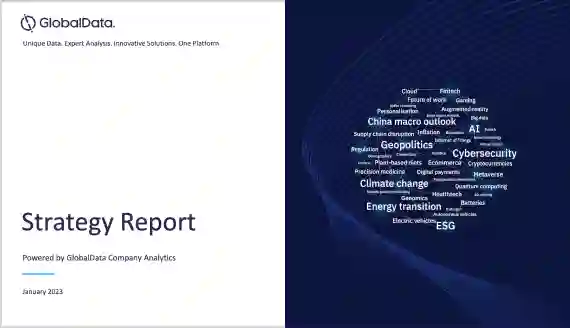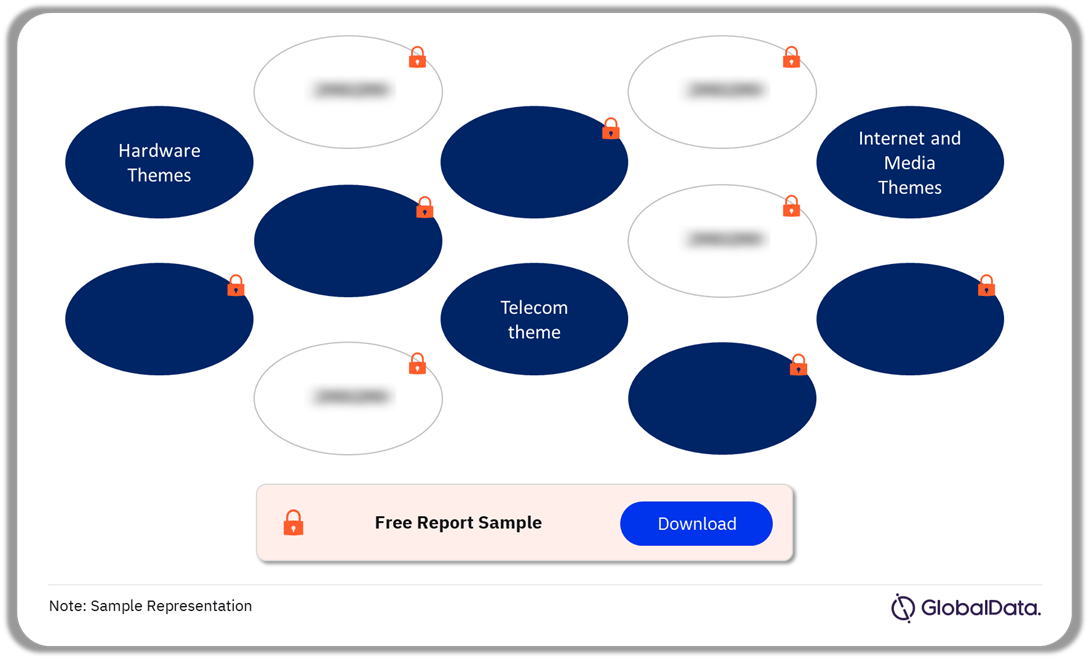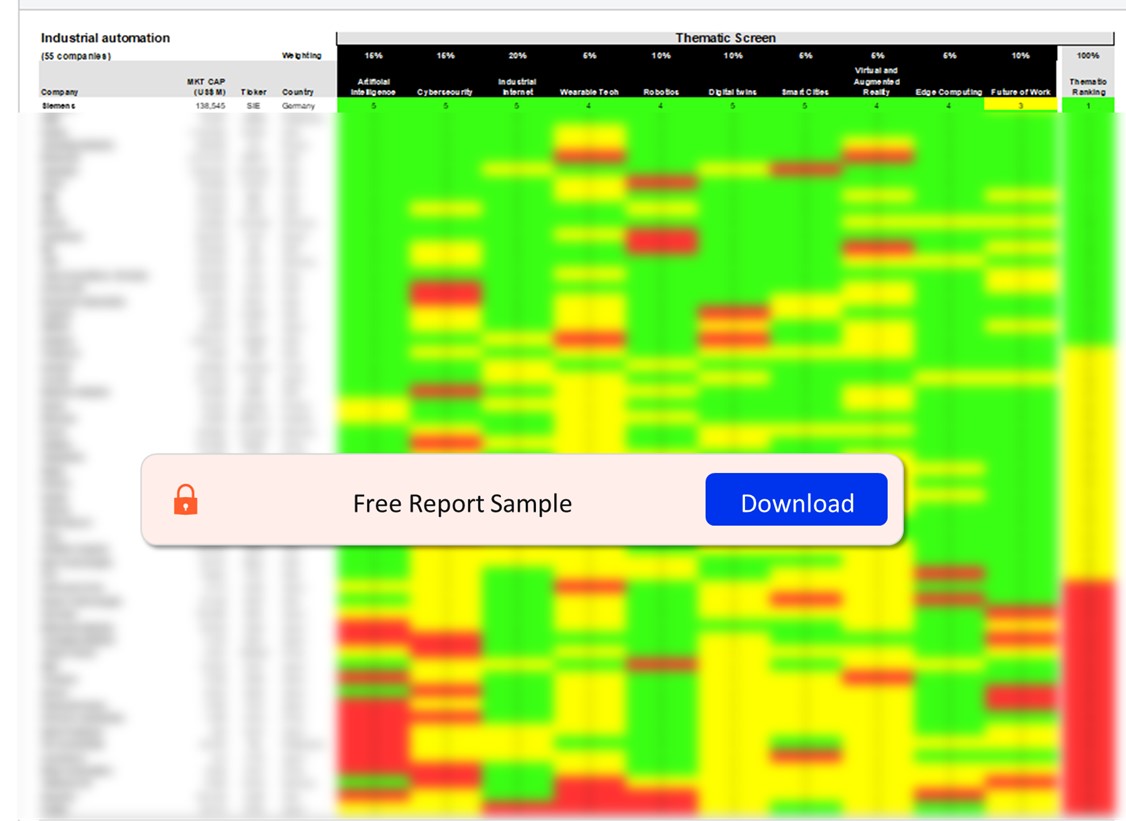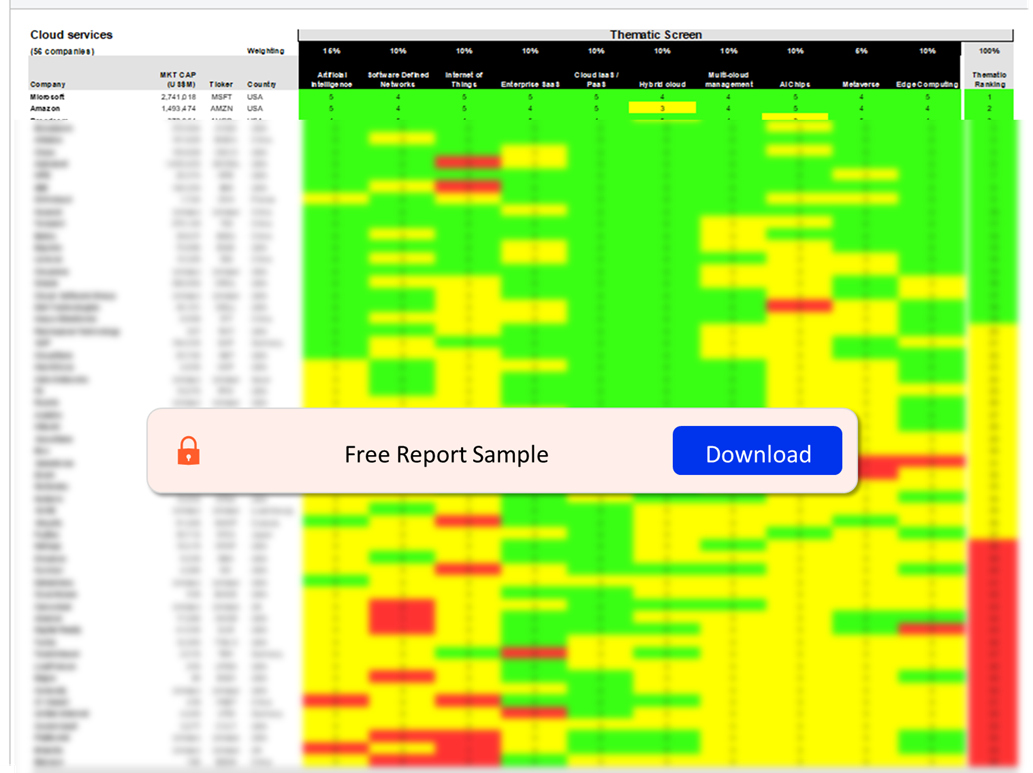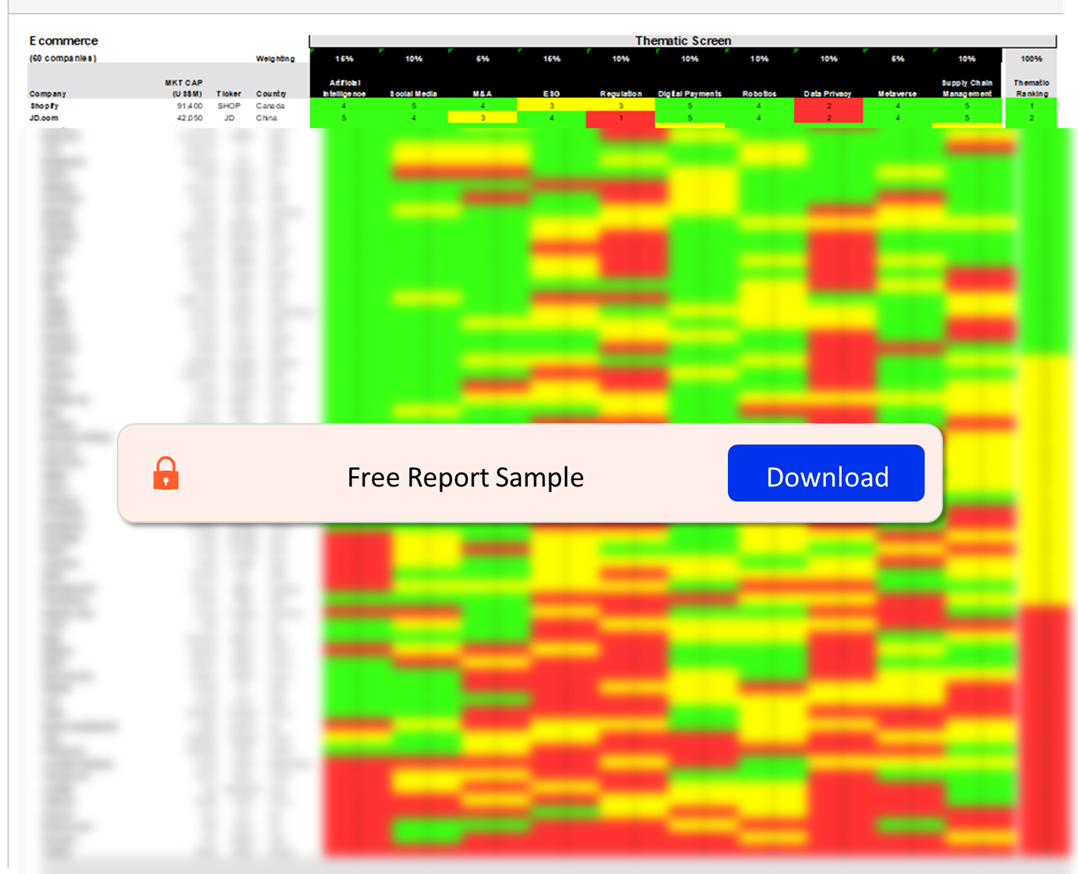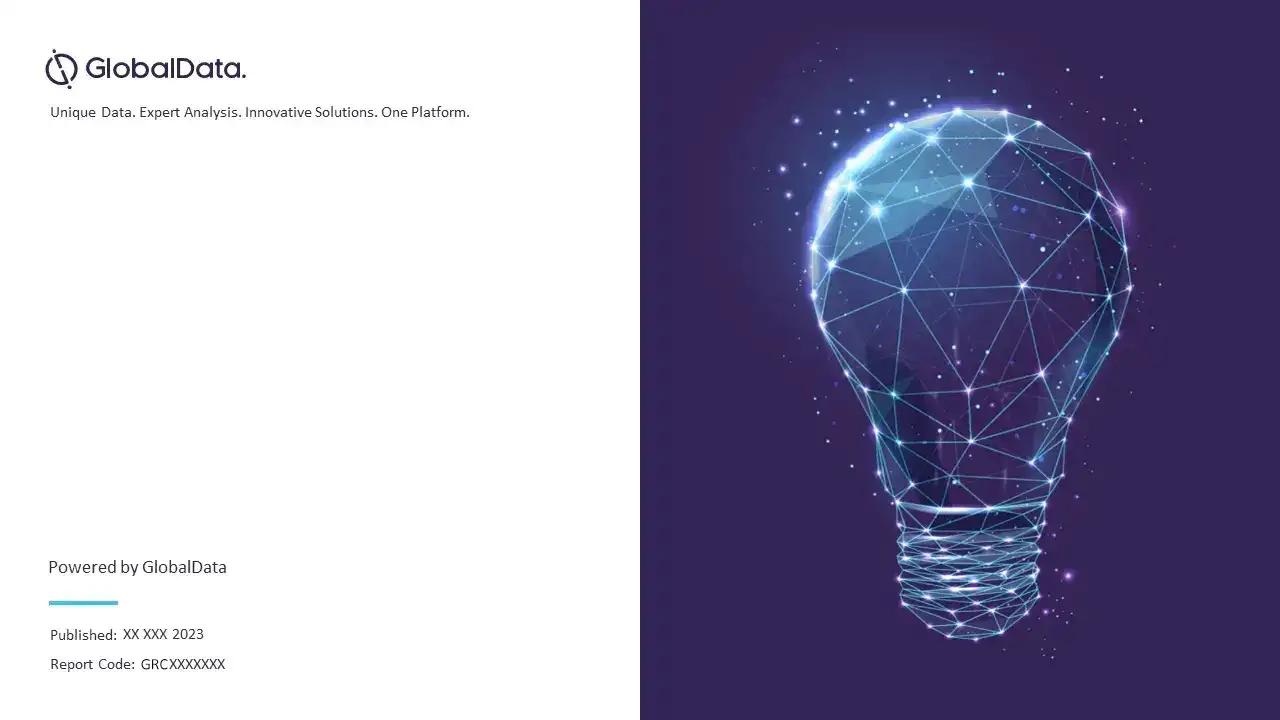Top Themes in Tech, Media and Telecom (TMT) in 2024 – Thematic Intelligence
Powered by ![]()
All the vital news, analysis, and commentary curated by our industry experts.
Viewing the world’s data by themes makes it easier to make important decisions. GlobalData’s Top Themes in Tech, Media, and Telecom (TMT) in 2024, report offers the following in-depth trends and insights:
- TMT SECTORS: Analysis of 17 TMT sectors, broadly divided into four categories: Hardware, Software and Services, Internet and Media, and Telecom.
- THEMATIC SCORECARDS: For each sector, we provide thematic scorecards comprising four screens: the company screen, the thematic screen, the valuation screen, and the risk screen.
- HOLISTIC VIEW: An easy-to-use framework tracking all themes across all companies in all sectors, with a unique thematic research ecosystem designed to give a holistic view of the big themes that are impacting companies in the TMT industry.
- The report features what’s happening, what are our predictions, who are the leaders and who are the laggers?
How is the ‘Top Themes in Tech, Media, and Telecom (TMT) in 2024’ thematic report different from other reports in the market?
- If you are worried about the pace of innovation in your industry, this report will help you identify which tech vendors can help you.
- It provides a top-down, comprehensive outlook for the leading players in the TMT industry based on the key themes set to transform their industry landscape over the next two years.
- Written by some of the world’s leading tech experts, GlobalData’s TMT Themes 2024 will help you look credible when discussing tech in your industry.
- It tells you everything you need to know about disruptive tech themes and which companies are best placed to help you digitally transform your business.
Investing in our Thematic Intelligence reports’ will enable you to invest in your future. We recommend this valuable source of information to anyone involved in:
- C-Suite
- Strategy
- Market Intelligence
- Competitor Intelligence
- Sales Enablement
- Digital Transformation
- IT
- Professional Services
To Get a Snapshot of the Top Themes in Tech, Media and Telecom (TMT) in 2024 Report
TMT Thematic Intelligence Report Overview
The TMT themes 2024 report provides readers an insight about disruptive tech themes and the companies that are best placed to help governments, and individuals adapt to upcoming digital transformations.
The biggest themes that are expected to drive growth in the TMT industry in 2024 are broadly categorized into four segments- hardware, software and services, internet and media, and telecom. The key themes in the hardware segment include semiconductors, component makers, consumer electronics, IT infrastructure, telecom infrastructure, and industrial automation.
Application software, gaming, enterprise security software, IT services, and cloud services are some of the themes driving growth in the software and services segment. Additionally, e-commerce, social media, advertising, music, film, and TV, and publishing themes come under the internet and media category. The report also discusses the telecom services theme and its impact on the TMT industry.
Top Themes Driving Growth in the TMT Industry
Buy the Full Report to Know More About the Top Themes Driving Growth in The TMT Industry
Download a Free Report Sample
The tech, media, and telecom (TMT) themes in the 2024 report provide a top-down, comprehensive outlook for the leading players in the tech, media, and telecom (TMT) industry. The report is based on the key themes set to transform the industry landscape over the next two years.
| Hardware Themes | · Semiconductors
· Component Makers · Consumer Electronics · IT Infrastructure · Telecom Infrastructure · Industrial Automation |
| Software and Services Themes | · Application Software
· Gaming · Enterprise Security Software · IT Services · Cloud Services |
| Internet and Media Themes | · E-commerce
· Social Media · Advertising · Music, Film, and TV · Publishing |
| Telecom Theme | · Telecom Services |
| Enquire & Decide | Discover the perfect solution for your business needs. Enquire now and let us help you make an informed decision before making a purchase. |
Industrial Automation
Technology and automation play a crucial role in building resilient businesses. Hence, industries are looking more seriously at emerging technology. Automation is especially needed to combat labor shortages, cut costs, and ease the negative consequences of supply chain disruption. This includes cybersecurity and technologies that replace human labor, such as robotics, or help workers collaborate remotely, such as digital twins, wearable tech, and virtual and augmented reality (VR and AR). In this context, technologies such as AI and the Industrial Internet will function as the backbone of industrial automation.
The top themes driving industrial automation are artificial intelligence, cybersecurity, industrial internet, wearable tech, and robotics among others.
Industrial Automation Thematic Screen
Buy the Full Report to Know How Industrial Automation Will Impact the TMT Industry
Download a Free Report Sample
Cloud Services
The cloud services sector is dominated by four major players, Amazon, Microsoft, Alibaba, Google, and Kyndryl. There will be no new entrant in 2024 that will significantly disrupt the status quo of these tech-giants owing to the capital cost involved in building the necessary infrastructure.
Few of the key themes driving cloud services are artificial intelligence, software defined networks (SDNs), the Internet of Things, Enterprise Software as a Service (SaaS), and Cloud Infrastructure as a Service (IaaS) and Platform as a Service (PaaS) among others.
Cloud Services Thematic Screen
Buy the Full Report to Know How Cloud Services will Impact the TMT Industry
E-Commerce
E-commerce gained significant momentum during the pandemic as physical stores temporarily closed for business worldwide. Technological innovations such as Artificial intelligence, social media, and robotics are helping e-commerce companies to stay afloat and retain their customers. While product quality is vital to customer satisfaction, vendors can harness the data insights, marketing opportunities, and delivery options these technologies provide to improve their operations.
Few of the key themes driving e-commerce are the metaverse, artificial intelligence, data privacy, supply chain management, and social media among others.
E-Commerce Thematic Screen
Buy the Full Report to Know How E-Commerce will Impact the TMT Industry
Telecom Services
Telecom carriers are facing global challenges owing to the global geopolitical situation and issues with supply chains caused by the COVID-19 pandemic. However, carriers continue to rationalize their offerings, influenced by advances in cloud, enterprise digitalization, and virtualization. To meet the needs of enterprises and consumers, telcos continue to become operationally agile in the way they connect in the digital ecosystem, bundle services, focus on customer experience, and introduce new business models in new segments.
The leading themes driving telecom services are 5G, cybersecurity, digitalization, the Internet of Things, and the future of work among others.
Telecom Services Thematic Screen
Buy the Full Report to Know How Telecom Services Will Impact the TMT Industry
Download a Free Report Sample
Key Highlights
As we enter 2024, the outlook is volatile and uncertain, primarily due to geopolitical turmoil and macroeconomic uncertainty. Technology can help businesses, governments, and individuals adapt to profound shifts in an uncertain world.
Artificial intelligence (AI) was the most talked about technology theme in 2023 and will remain at the top of agendas. From a business perspective, AI represents both an opportunity and a threat, and the companies that succeed will approach it as such rather than seeing it as a cure for all ills.
ABB
Accenture
Accton
Acer
Adobe
Adtran
Advance
Advanced Info Service
Airbnb
Aixtron
Akamai
Alarm.com
Alcatel-Lucent Enterprise
Alibaba
Alibaba Pictures
Alphabet
Alteryx
Altice
Amazon
Ambarella
AMC Entertainment
AMC Networks
AMD
Amdocs
America Movil
Amphenol
AMS
Analog Devices
Ansys
AO.com
Apple
Applied Materials
Arista Networks
Arm
Asia Optical
ASML
ASOCS
ASOS
Asus
AT&T
Atos
Atresmedia
Autodesk
Automation Anywhere
Aviatrix
Axel Springer
BAE Systems
Baidu
Bandai Namco
Baozun
Barracuda Networks
BCE
Bentley Systems
Bertelsmann
Bharti Airtel
Bilibili
Bitmain
Bizlink
Blackbaud
Blackberry
Blackline
Bloomberg
Bonnier
Boohoo.com
Booking Holdings
Bosch
Box
Boyaa
BrainChip
Broadcom
BT
Bureau Veritas
BYD
ByteDance
Cadence Design Systems
Calix
Cambricon
Cambridge University Press
Canon
Canonical
Capcom
Capgemini
Casa Systems
Catcher Technology
CATL
Cato Networks
CelcomDigi
Cengage
Cerebras
CGI
Charter Communications
Check Point Software
Chegg
Cheil
China Literature
China Mobile
China Telecom
China Unicom
Chunghwa Telecom
Ciena
Cineworld
Cirrus Logic
Cisco
Clarivate
Clear Channel
Cloud Software Group
Cloudera
Cloudflare
Cognex
Cognizant
Cohesity
Colopl
Comcast
CommScope
CommVault
Compal
Compass
Computacenter
Comscore
Concentrix
Conduent
Constellation Software
Corning
Couchbase
Coupa
Cox
Criteo
CrowdStrike
CSG Systems
CyberArk Software
Cyberdyne
Cybereason
Daily Mail and General Trust
Danaher
Darktrace
Dassault Systemes
Databricks
Datadog
Dawning
Deliveroo
Delivery Hero
Dell Technologies
DeNA
Dentsu
Deutsche Telekom
Didi Chuxing
Digital Realty
Diodes
Discord
Dish Network
DJI
DocuSign
DoorDash
Dropbox
DXC Technology
Dynatrace
E& (Etisalat)
Ebay
Edgio
Electronic Arts
Embracer
Emerson Electric
EPAM Systems
Epic Games
Equifax
Equinix
Ericsson
Estun Automation
Etsy
Euromoney
Exabeam
Expedia
Experian
Extreme Networks
F5
FactSet
FANUC
FICO
Finastra
Forcepoint
Fortinet
Fuji Media
Fujitsu
Gakken
Gamevil
Gannett
Garmin
GE
Genpact
GlobalFoundries
Globe Telecom
GoDaddy
GoerTek
GoPro
Graphcore
Gree
Groq
Groupon
Grupo Planeta
Grupo Televisa
Guardian Media Group
GungHo Online
Haier Smart Home
Harmonic
Harmonic Drive
HashiCorp
HCLTech
Hearst
Hikvision
Himax
Hitachi
Hitotsubashi Group
HollySys Automation
Holtzbrinck Publishing
Hon Hai
Honeywell
Horizon Robotics
Houghton Mifflin Harcourt
HP
HPE
HTC
Huawei
HubSpot
IAC
IBM
iFlytek
IGG
Iliad
Indra Sistemas
Infineon
Infinera
Info Edge
Infor
Informa
Infosys
Inspur Electronic
Instacart
Intel
Interpublic
Intuit
Intuitive Surgical
Inventec
IonQ
iQiyi
iRobot
ITV
Jabil
Japan Display
JC Decaux
JD.com
Juniper Networks
Just Eat Takeaway
Justdial
Kadokawa
Kakao
Kawasaki Heavy
KDDI
Keyence
Kingsoft
Klarna
Kodansha
Konami
KPN
Krafton
KT
KUKA
Kyndryl
Kyocera
Lagardere
LAM Research
Lamar Advertising
Largan
Lenovo
LG Display
LG Electronics
LG Energy Solution
Lionsgate
Live Nation
LivePerson
Logitech
LTI
Lumen
Lumentum
Lyft
M&C Saatchi
M1
M6-Metropole TV
Magic Leap
Magnite
MakeMyTrip
Marchex
Marvell
Mastercard
Mavenir
Maxis
McGraw Hill
MediaForEurope
MediaTek
Meituan
Melexis
MercadoLibre
Meta
Microchip
Micron
Microsoft
Mimecast
Mirantis
Mitsubishi Electric
Mixi
Mobily
Momo
MoneySuperMarket
Monolithic Power Systems
Moody's
Morningstar
Motorola Solutions
Mphasis
MTN Group
Murata
Mythic
Nabtesco
Nachi Fujikoshi
Nanya Tech
Naspers
Naver
NavInfo
NCC
NCSoft
NEC
NetApp
NetEase
Netflix
Netmarble
Netskope
Network 18 Media
Neusoft
New Relic
New Work
New York Times
News Corp
Nexon
Nexstar
Nfon
Nielsen
Nikon
Ningbo Bird
Nintendo
Nippon Ceramic
Nippon TV
Nokia
NTT
NTT Data
Nutanix
Nvidia
NXP
Ocado
Okta
Omnicom
Omron
On Semiconductor
Ooredoo
OpenAI
OpenText
Oracle
Orange
Outfront Media
OVHcloud
Oxford University Press
Palantir
Palo Alto Networks
Panasonic
Parallel Wireless
Paramount Global
Parrot
PayPal
Paytm
Pearson
Pegatron
Perfect World
Philips
Phluido
Phoenix Publishing & Media
Pinduoduo
Platform9
Playtech
PLDT
Progress Software
Proofpoint
ProSiebenSat.1
Proximus
PTC
Publicis
Pure Storage
Qisda
Qorvo
Qualcomm
Qualys
Quanta Computer
Quantinuum
Quebecor
Rackspace Technology
Radisys
Radware
Rakuten
Rapid7
Razer
Rea Group
Reliance Industries
Relx
Renesas
Renren
Ribbon Comms
Ricoh
Rigetti Computing
RingCentral
Roblox
Rockwell Automation
Rogers Comms
Rohm
Roper Technologies
RTL
Rubrik
S&P Global
Sage
Sage Publishing
SAIC
SailPoint Technologies
Salesforce
SambaNova
Samsung Electronics
Samsung SDI
Sanoma
SAP
Saudi Telecom
Schibsted
Schneider Electric
Scholastic
Sea
Seagate
SecureWorks
Securonix
Sega Sammy
Seiko Epson
Sensata
SenseTime
SentinelOne
ServiceNow
Sharp
Shein
Shopify
Siasun Robot
Siemens
Silicon Labs
Silicon Motion
Sina
Singtel
Sirius XM Radio
SK Hynix
SK Telecom
Skyhigh Security
Skyworks
SMEE
SMIC
Snap
Snap One
Snowflake
Snyk
Softbank
Software AG
Sonos
Sony
Sophos
Sopra Steria
Spark New Zealand
Splunk
Spotify
Square Enix
SS&C
STMicroelectronics
Stryker
Sumo Logic
Sun TV Network
Suning.com
Sunny Optical
SUSE
Swisscom
Synaptics
Synopsys
SynSense
Take-Two Interactive
TAL Education
Tanium
Tata Communications
Tata Consultancy Services
TDK
TE Connectivity
TeamViewer
Tech Mahindra
Tegna
Telecom Italia
Telefonica
Telekom Malaysia
Telekomunikasi Indonesia
Telenor
Television Broadcasts
Telia
Telstra
Telus
Temenos
Tenable
Tencent
Teradata
Teradyne
Tesla
Texas Instruments
TF1
Thales
Thomson Reuters
TietoEVRY
T-Mobile US
Tokyo Electron
TomTom
Toshiba
Toyota
Trade Desk
TransUnion
Trellix
Trend Micro
Trip.com
TripAdvisor
TSMC
Twilio
Uber
Ubiquiti Networks
Ubisoft
UiPath
UMC
Umicore
United Internet
Unity Technologies
Universal Music
UScellular
Valve
Vantiva
Vecima
Verisk Analytics
Verizon
Viaplay
Vipshop
Visa
Vivendi
VK
Vodacom
Vodafone
Vuzix
Walmart
Walt Disney
Warner Bros. Discovery
Warner Music
Wayfair
Webzen
Wiley
Wipro
Wistron
Wolters Kluwer
Workday
Workiva
World Wide Technology
WPP
X (formerly Twitter)
Xero
Xiaomi
Yandex
Yaskawa
Yelp
Yokogawa Electric
Yuneec
YY
Z Holdings
Zain
Zalando
Zapata Computing
Zee Entertainment
Zendesk
Zillow
Zoom
Zscaler
ZTE
Table of Contents
Frequently asked questions
-
Which key themes will drive industrial automation in the TMT industry in 2024?
The key themes driving industrial automation in the TMT industry in 2024 are artificial intelligence, cybersecurity, industrial internet, wearable tech, and robotics
-
Which key themes will drive cloud services in the TMT industry in 2024?
The key themes driving cloud services in the TMT industry in 2024 are artificial intelligence, software defined networks (SDNs), Internet of Things, and Enterprise Software as a Service (SaaS) among others.
-
Which key themes will drive e-commerce in the TMT industry in 2024?
The leading themes driving e-commerce in the TMT industry in 2024 are the metaverse, artificial intelligence, and data privacy among others.
-
Which key themes will drive telecom services in the TMT industry in 2024?
The key themes driving telecom services in the TMT industry in 2024 are 5G, cybersecurity, digitalization, the Internet of Things, and the future of work.
Get in touch to find out about multi-purchase discounts
reportstore@globaldata.com
Tel +44 20 7947 2745
Every customer’s requirement is unique. With over 220,000 construction projects tracked, we can create a tailored dataset for you based on the types of projects you are looking for. Please get in touch with your specific requirements and we can send you a quote.
Related reports
View more Technology reports


